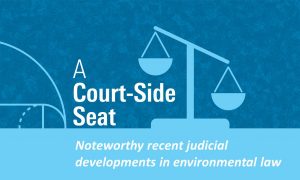Five Predictions for the UPC on Day One
“The UPC will become a success story, since there are simply no good reasons not to engage with the Court.”
Graphic: UPC website
The Unified Patent Court (UPC) is now a reality. The Court opens its doors tomorrow, June 1, 2023. In the past four articles, we have aimed to dispel myths about some of the key aspects of the UPC. Part 1 focused on the designated UPC judges, Part 2 on the timelines, Part 3 on the remedies that are available at the UPC and finally Part 4 on the financial aspects of the UPC. These articles illustrated that the UPC will become a success story, since there are simply no good reasons not to engage with the Court. This final installment to the series will provide five predictions about how the UPC will operate. We’ll review in 12 months where our peek into the crystal ball got it right, and where it missed the mark.
Prediction 1: More than 100 infringement actions filed in week one
The big unknown is, of course, whether the new UPC system will in fact be frequented by the patent community or whether a “wait and see” approach will be adopted. The answer to this question will be available in real time, and UPC statistics will be a constant companion in the future. EU patent litigation will consequently become more transparent than it was in the past. This is due to the access rights that are afforded to the public by Rule 262 of the UPC Rules of Procedure (ROP). Of course, it is difficult to tell exactly how many cases will be filed in week one after the UPC has opened its doors for business. However, it is not far-fetched to assume that most patent firms in Europe are keen on bringing at least one UPC action in order to be able to present a credible UPC pitch to their clients. A “fake it, then make it” principle will not work for pitching UPC cases, partly in light of the financial exposure involved. In addition, enforcement-savvy patent owners likely have stayed away in recent months from bringing their cases to national venues and will have reserved these actions for the UPC. Given the fact that, in total, 17 EU countries are involved at the beginning of the UPC system, it is fair to assume that far more than 100 actions will be filed in week one.
Prediction 2: Less than 100 standalone revocation actions filed in week one
The whole opt-out discussion was and still is dominated by the fear that a central revocation action will be filed by competitors with the UPC in order to invalidate a “crown jewel” European Patent for which the time window to file European Patent Office (EPO) opposition proceedings already lapsed. In practice, this hypothetical will be the exception rather than the rule. This is due to the cost risk associated with filing a central revocation action with the UPC where a “loser pays”-system applies. Whereas the UPC court fees for filing such action are capped to EUR 20,000, the cost risk for bearing the patentee’s costs for legal representation in case the revocation action is unsuccessful is only capped at an upper limit of EUR 2 million. Thus, if in-house decision makers are presented with a complete set of facts, it is rather unlikely that they will green light a central UPC revocation action without further ado. In light of this, we will likely see few standalone central revocation actions, and likely also far less than 100 filed in week one.
Prediction 3: More than 50% of all plaintiffs will not be headquartered in a UPC Member State
Let’s be fair. The UPC will neither be the right venue for small and medium sized enterprises (unless they are patent savvy and well-funded) nor for small claims cases. This prediction entails that we will see sophisticated patent holders as UPC plaintiffs who are already very experienced in national EU patent litigation and who are keen on entering this new playing field to leverage their patent portfolios. This assessment implies that the main users of the new system will be the global players already known from high-profile national patent litigation cases. However, these players are often not headquartered in the EU. Thus, patent litigation among non-European players will be the rule, rather the exception. It is likely that more than 50% of all plaintiffs will not be headquartered in a UPC Member State.
Prediction 4: All industries will bring their cases to the UPC
Rumor has it that we will only see telecommunication cases in the early phase of the UPC and no life science and pharma cases. This assumption is likely flawed, as we currently observe in the patent world a convergence of life science and pharma cases on the one hand, and software cases on the other hand. More importantly, the Agreement on the UPC (UPCA) and the ROP do not favor certain technologies over others. The only argument that has some merit is the fact that a central revocation action might be too risky in situations where the patentee owns only one granted patent for a certain innovation and if there are no further options for the patentee to expand this patent family by filing divisional applications and/or utility models. Apart from this exception, the UPC is a very good choice for all types of technologies and not only for the telecom world.
Prediction 5: Generous Preliminary Injunction practice
We can anticipate that the UPC will adopt a generous practice for preliminary injunctions (PIs). In the first place, no battle-tested patent will be needed for requesting interim relief. This is due to the fact that the Court of Justice for the European Union recently emphasized that a granted patent is per se a suitable PI basis, since it enjoys the presumption of validity as an examined proprietary right (cf. Phoenix Contact / Harting). Also, there will likely be no strict urgency requirement in the sense that the patentee needs to request interim relief within a month after the patentee learned about the accused product and the infringer. The Agreement on the Unified Patent Court and the ROP are silent on such a requirement and many UPC Member States entertain a very generous approach in this regard anyway (e.g. France, Netherlands and Austria). Last, but not least, we may even see cross-border preliminary injunctions issued by the UPC covering EU Member States that are not UPC Member States. It would not come as a surprise if the UPC were to follow this governing Dutch practice, since the Court of Justice for the European Union paved the way for such practice in its Solvay / Honeywell decision.
The Ultimate Goal: Harmonization
In a nutshell, the founding fathers of the UPC have done a great job by establishing a court system that is able to efficiently and timely deal with patent disputes. This system is operated by the best-in-class judges who will put their personal stamp on the system and will proactively shape it in the upcoming years. Harmonization will be a top priority so that the UPC will not only aim to unify the case law of its various divisions (i.e. local divisions, regional divisions and central division), but also the patent law of the entire European Union.
Tobias Wuttke
Dr. Tobias Wuttke is a Partner and attorney-at-law with BARDEHLE PAGENBERG where he specializes in national and cross-border patent litigation. Influential rankings confirm his reputation as one of Germany’s leading […see more]







